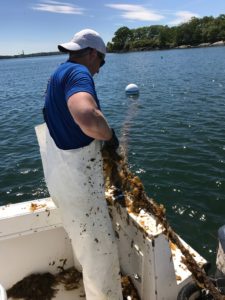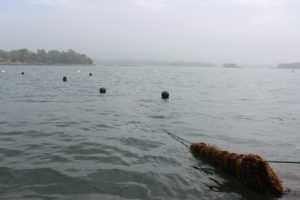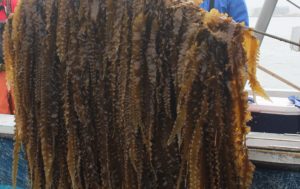Independent Farmers Explore Seaweed for a Marine Based Economy
There are now opportunities for entrepreneurially-minded people to enter the seaweed farming business and have a chance to succeed.
The article is part two of a two-part series on ocean aquaculture. In part one, we learned about Bren Smith’s system of regenerative, multispecies ocean farming with sugar kelp and shellfish. Here, Todd Jagoutz, co-founder of Sea Greens Farms, discusses his vision of job creation through populating the coast with productive, regenerative seaweed farms.

Todd Jagoutz working longlines of sugar kelp.
Courtesy of Todd Jagoutz
Todd Jagoutz grew up in Duxbury, Massachusetts, where fishing and exploring the mudflats and harbors of the bay occupied his early years. “They were just starting to grow oysters in the bay back then,” says Todd when asked of his roots. After taking a degree at the University of Maine in 2001 his thoughts returned to his hometown where the bay was full of oyster farms and thought “oh man, I missed it!” Being a native of the estuary and attuned to the breathing of the ocean, Todd reflected on this lost opportunity and began to consider how he could get into the business.
He had an acute business mind and wanted to put it to good use. He wanted to think big about the issues around jobs and the environment that he was seeing along the coast, and he wanted to do something about it. Being familiar with the oyster farmers on the bay where he grew up, he sought an enterprise that would manifest his deep love of the ocean, and seaweed kept popping up on his radar. The more he looked, the more he learned about the tremendous attributes of seaweed, specifically sugar kelp; its ability to take up excess nutrients in the water; the habitat it provides for marine life; the fact that it takes no inputs whatsoever, such as fertilizer and pesticides; and that his new home in Maine was one of the best places to grow it.
In 2015, while he was still working in corporate sales, Todd decided to give it a go and started off as a kelp farmer working on the water he loved. It wasn’t long before he began to run up against a big problem. His website notes “[he] quickly realized that the nascent farmed seaweed industry lacked the processing and distribution infrastructure to support the growth in seaweed farming…” There was no one on the back end to buy his crop. He could grow it and was confident in the quality of his raw product, but there was no infrastructure to process and market kelp in Maine. Without a market outlet, his business plan as a farmer didn’t work. After a year of farming kelp, learning farm operations, and honing his skills on the water, he began to think about how he could use his business acumen to impact the marketing side. Todd longed to make a legacy for his family, and in 2017, after much reflection, he left his corporate job and moved to Cumberland, Maine. The travel and the demands of the corporate world behind him now, he focused on his family and his renewed passion … making a living on being connected to the sea.

The low impact view of a kelp farm.
Lee Rinehart / NCAT
Farming seaweed was a thought incubator for Todd. He saw the marketing and processing roadblock, but knew Maine’s workforce of fishers and aquaculturists, who for generations had made their living on the water, were generally open to new ideas. There was latent capacity in the state to retool the watermen’s skills to growing sugar kelp. The questions that guided him as a farmer now became a sort of vision statement: “As a farmer, I think I can learn how to grow it,” says Todd. “But who will I sell it to? Then, how much would I get for my crop?” No one could answer these questions. So Todd set out to find the answers, and Sea Greens Farms was born.
Todd got busy trying to figure out how to make it work. Lots of conversations, lots of coffee and research, and then he met Norman Villarina, Mike Shim, and David Williams, now his business partners. They now had the collective expertise in kelp culture, food system marketing, start-up knowledge, finance, and consumer product development. Sea Greens Farms began purchasing, processing, and moving seaweed across the country, and is now the largest supplier of farmed seaweed in the United States. With a focus of creating a “blue green economy,” its mission is to create jobs and opportunity for the working waterfront, and since 2015, according to Todd’s back of the envelope math, the kelp industry in Maine has grown more than 500 percent.
Sea Greens Farms started out doing something that no one else was doing: purchasing and processing only farmed seaweed, as opposed to seaweed collected in the wild. They wanted to purchase only from independent farmers like Colleen Francke, a commercial fisher who diversified her operation to include kelp farming. Colleen will supply Sea Greens Farms with close to 50 tonnes of kelp in the spring of this year. A deep connection to the people on the waterfront, including farmers like Colleen, gives Todd and his partners a keen understanding of what farmers are going through in order to provide them with an infrastructure tailored to their needs. Todd’s earlier farming experience, and his relationship with farmer suppliers, are crucial to his business, and highlights the farmer support elements of Sea Greens Farms.
Developing and Supporting Farmers on the Waterfront
Todd’s burning questions dealt with finding a kelp buyer and knowing the price a farmer would receive. With Sea Greens Farms he is able to help farmers navigate these questions with a triad of processing, market access, and technical assistance. The heart of the business is the processing facility that receives raw kelp from local farmers and turns it into what customers want, whether it be blanched and frozen, dry products, or milled products as used in seasonings. Sea Greens Farms is a wholesale distributer that evolved from a distribution model that sold mostly to restaurants for cash flow, and has now moved into being a nationwide wholesaler for products that are ready to eat and ready for further processing. This model serves Maine farmers by expanding their market reach and is one reason why the small scale kelp industry has grown since 2015.

Kelp harvest.
Lee Rinehart / NCAT
The Sea Greens Farms facility also includes a hatchery and nursery that provides seed to farmers. The sugar kelp farming process starts in the fall, when spores are collected from kelp growing in the water. At this time, reproductive structures called sori have developed, which appear as darkened spots along the length of the kelp’s leaf, or frond. Fronds with sorus tissue are harvested and taken to the hatchery for processing, where the tissue is cleaned, excised under controlled conditions, and placed in a container of seawater with culture nutrients, where a submerged spool of string serves as the substrate for the spores to attach and begin to grow. After a little over a month, the spores will have populated the string on the spool, and it is ready to be planted in on the farm site.
Inoculating seed string is a complex process, with a series of controls that ensures successful seed development. Sea Greens Farm’s facility provides a much-needed service, as most farmers do not have the time, resources, or facilities for managing a kelp nursery and hatchery. Having access to viable seed is crucial for kelp farmers, and Todd wants to help others by providing start-up technical assistance, as well as seed free of charge to farmers who sell their product to them. “Having more seaweed farmers benefits everyone,” says Todd, “as well as the ocean, the marine based economy, and our tiny industry.”
On the market side, many farmers sell direct to restaurants. This is typically a local market and it works well for some entrepreneurial-minded people. For others, distribution to retail, supermarkets, and online can be a viable outlet. But Sea Greens Farms focuses on the wholesale marketplace. The more Todd can sell (and create the biggest volume), the more farmers he will need, and more farming opportunities are created. “What is happening now,” notes Todd, “is that the first ripples of a wave of food manufactures are looking at plant-based food protein alternatives,” and sugar kelp fits this niche. Akua, a company dedicated to sustainable, restorative ocean use, develops products made from ocean-farmed kelp. Their kelp jerky has a texture similar to meat-based jerky, but is vegan and kelp-based. Products like these are emerging now, suggesting that we are getting ever closer to supporting a cadre of local, independent farmers on the waterfront.
How to Get Started in Kelp Farming
Jagoutz is passionate about his trade and the coastal region of the Northeast. His enthusiasm is evident when he talks, and he peppers his language with visions of diversity, sustainability, and regeneration. And he is always willing to help a prospective farmer navigate the often-confusing landscape of kelp farming. His advice to beginners is to first write a business plan. You’ve got to know your costs. You also need to have access to a boat, and have a working knowledge of being safe on the water. Most kelp farm operations occur in the winter, and safety is a crucial element in farm operation.
Talk to as many people as you can. Seek advice from universities. Many in the Northeast have aquaculture programs. Talk to Todd, talk to everyone you can to get an understanding whether kelp farming is the right enterprise for you. Then, when you have your plan and a potential farm site, the next step is leasing a specific space from the state. You can’t do this alone, and there are many resources available, including Sea Greens Farms, that can help demystify the industry and provide the knowledge they have learned on the water.
Get a boat, understand farm operations, and secure a market that will pay. “If you’re passionate about it,” Todd suggests, “you love growing things, and you are interested in positively impacting the environment, this is for you. You’ll worry about it, you’ll check it often, and all of a sudden it grows. It’s a very fulfilling process. There is a magical feeling and experience when you are on the water and doing something good.”
Sea Greens Farms, was founded in 2015 to encourage and support the growing regenerative ocean farming economy and make a positive impact on our communities and environment through jobs and meaningful livelihoods for people on the water. If you are interested in becoming a regenerative kelp farmer, or just want to learn more about sustainable farming in the ocean, visit Sea Greens Farms online at http://www.seagreensfarms.com/.
Ocean Approved’s Kelp Farming Manual discusses the details of farm site selection, farm system construction, the site lease application, nursery procedures, and farm site operations: https://www.researchgate.net/publication/311946411_Kelp_Farming_Manual_a_Guide_to_the_Processes_Techniques_and_Equipment_for_Farming_Kelp_in_New_England_Waters

